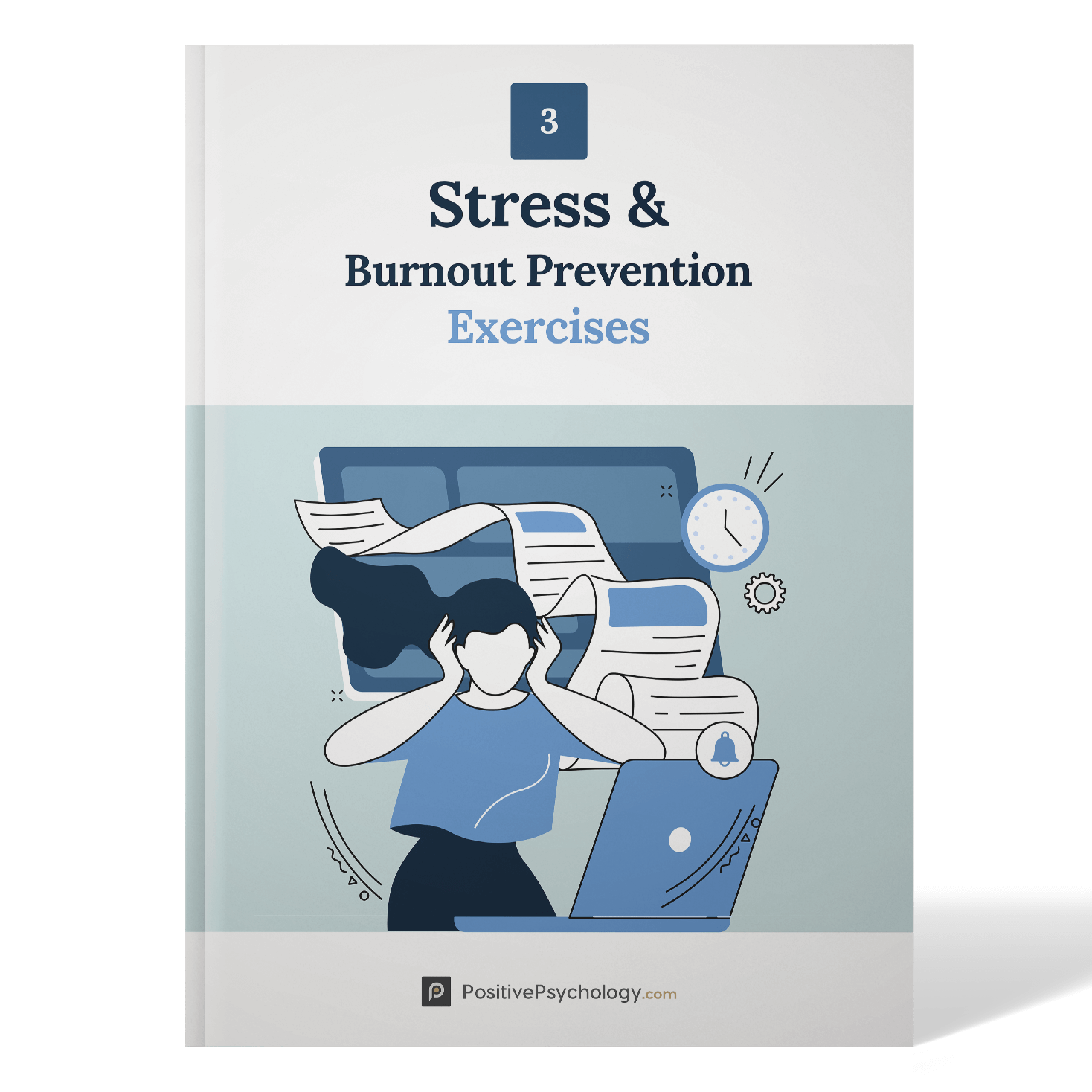

Stress is a factor in 7 out of the top 10 causes of death worldwide, and the workplace is an important contributor (Quick & Henderson, 2016).
An American Psychological Association survey found that 31% of staff felt stressed out during their workday (cited in Tetrick & Winslow, 2015).
Help is available. Workplace stress management and wellness programs can help reduce the degree and impact of stress and restore an employee’s depleted psychological resources (Tetrick & Winslow, 2015).
This article explores what we mean by workplace stress management and introduces mechanisms and activities that can provide relief and help staff cope.
Before you continue, we thought you might like to download our three Stress & Burnout Prevention Exercises (PDF) for free. These science-based exercises will equip you and those you work with with tools to manage stress better and find a healthier balance in your life.
The relationship between the workplace and our psychological, cognitive, and physiological responses to stress is complex, impacted by “a broad set of occupational and work demands as well as environmental stressors” (Quick & Henderson, 2016, p. 2).
And yet, our stress response at work can typically be attributed to one of the following four workplace demands (Quick & Henderson, 2016):
Workplace stress management (WSM) has been significantly influenced by the theory of preventive stress management, introduced in 1979, which proposes that it is not the stimuli that decide the degree of stress experienced by the individual, but the individual’s response to those stressors (Hargrove, Quick, Nelson, & Quick, 2011).
Over the years, many theoretical frameworks and organizational wellness programs that fall under the umbrella term of WSM have been proposed to understand occupational stress and employee wellbeing. WSM aims to understand specific stressors and take positive steps to reduce their effects (Tetrick & Winslow, 2015).
WSM interventions are typically divided into three types:
Stress interventions include (modified from Tetrick & Winslow, 2015):
Such interventions are often used in combination to prevent, reduce, and cope with stress.

Practical and effective primary interventions can reduce or remove the need for secondary and tertiary interventions focused on recovery from stress (Tetrick & Winslow, 2015).
While many of the following strategies appear simple, they require focus and commitment. Others foster a new mindset and change how we relate to work and occupational stress.
Our brains are constantly flooded with increasing demands and information, causing us stress and reducing our ability to focus and solve problems.
There are many steps we can take to avoid or reduce stress, including promoting positive emotions, taking physical care of our brain, and becoming more organized (modified from Hallowell, 2014).
Demanding jobs, long hours, and increasing workloads can leave us feeling emotional, disengaged, stressed, and exhausted (Schwartz & McCarthy, 2014).
Creating a series of habits, practices, and rituals can promote your physical, emotional, mental, and spiritual energy (modified from Schwartz & McCarthy, 2014).
We all have finite limits before reducing energy levels and increasing stress interrupt what we can achieve. Investing in healthy work habits can maintain productivity and performance throughout the day.

These detailed, science-based exercises will equip you or your clients with tools to manage stress better and find a healthier balance in their life.
Download PDF
By filling out your name and email address below.
How we experience and handle stress changes its cognitive, emotional, and behavioral impact (Crum & Crum, 2018). The following two coping mechanisms offer practical approaches for managing stress in the workplace and can be implemented with little training.
Research has confirmed the success of mindfulness at reducing perceived stress and emotional exhaustion, and improving sleep quality and job satisfaction (Tetrick & Winslow, 2015).
While we may sometimes think of mindfulness as passive and accepting, it is often the first step toward growth and change. While incredibly valuable for handling life stresses, it is also powerful enough to enrich positive and happy times in our lives (Shapiro, 2020).
Mindfulness expert Shauna Shapiro (2020) considers three points essential to mindfulness:
A review of the literature confirms that mindfulness is a powerful and cost-free approach to coping with stress (Shapiro, 2020).
While we are familiar with the negative impacts of stress, we sometimes forget that achieving a stress-free life is unlikely and, perhaps, impossible (Crum & Crum, 2018).
We must recognize that some degree of stress is crucial to our personal and professional growth. Stress reminds us that something is important to us, that we care.
People who adopt a “stress is enhancing” mindset rather than a “stress is debilitating” mindset perform better and experience fewer negative health consequences (Crum & Crum, 2018).
But how do we see stress differently?
We can rethink stress using the following three steps (Crum & Crum, 2018; Crum, Salovey, & Achor, 2013):
“I am stressed about my job interview.”
“I am stressed about finals.”
Acknowledging stress can help you move brain activity from being automatic and reactive to conscious and deliberate.
Even with long-term, chronic stress at work, you can recognize opportunities for learning, growth, or the motivation to change yourself or your situation. While it may not always be possible, if you can find a way to embrace stress, it can become a “powerful tool for helping you overcome the inevitable challenges that can – and will – arise” (Crum & Crum, 2018, p. 75).

The Positive Psychology Toolkit© is a groundbreaking practitioner resource containing over 500 science-based exercises, activities, interventions, questionnaires, and assessments created by experts using the latest positive psychology research.
Updated monthly. 100% Science-based.
“The best positive psychology resource out there!”
— Emiliya Zhivotovskaya, Flourishing Center CEO
The following worksheets share the same goal: to reduce stress.
Your resources (internal and external) provide a potentially limitless amount of support that will sustain you during challenging times and stressful situations (Niemiec, 2019).
The Identifying Your Stress Resources worksheet helps you recognize your resources and identify how they can support your strengths.

Decision-making takes time. The effect of weighing up pros and cons uses up precious resources and risks adding to an already stressful workload.
The Stress Decision Framework worksheet helps you put decision-making in context, aiming for a good enough, not perfect, decision (Armstrong, 2019).
Stress is a choice, yet it is often perpetuated by negative (vicious) cycles of thinking (Armstrong, 2019).
It doesn’t have to be this way.
Using a cognitive-behavioral approach, it is possible to reframe unhelpful beliefs and thinking, and adopt a virtuous cycle of thinking.
The Vicious Versus Virtuous Stress Thinking worksheet helps you compare unhelpful and helpful thinking regarding an event (Armstrong, 2019).